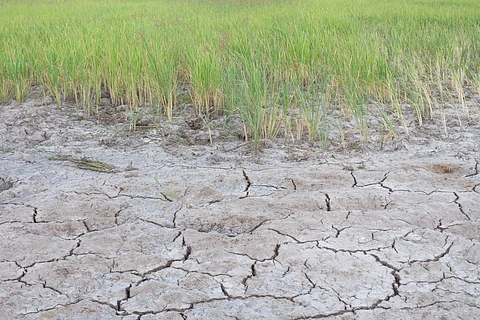

Nearly 1.4 billion hectares of land, or 10.7 per cent of the global land area, is affected by salinity, according to a new report by Food and Agriculture Organization (FAO) of the United Nations. This, coupled with an additional billion hectares at risk due to climate change and human mismanagement, poses a threat to global food security.
The report, titled The Global Status of Salt-Affected Soils, was released on December 11, 2024 and is FAO’s first major global assessment of salt-affected soils in 50 years. The report was launched during the International Soil and Water Forum 2024 in Bangkok, co-organised by FAO and Thailand’s Ministry of Agriculture and Cooperatives, to discuss an action plan for halting and reversing soil degradation and water scarcity.
Salt-affected soils are a specific group of soils that have elevated amounts of soluble salts (saline soils) or exchangeable sodium (sodic soils) that adversely affect the growth of most plants.
Excessive salinity reduces the fertility of soils and severely impacts environmental sustainability. In the countries most affected by this issue, salinity stress can lead to crops yield losses — such as rice or beans — of up to 70 per cent.
New estimates on the basis of FAO’s global map of salt-affected soils indicated that 10 per cent of irrigated cropland and 10 per cent of rainfed cropland were affected by salinity, potentially threatening food security.
The affected area may further increase to between 24 per cent and 32 per cent of the total land surface under the existing trend of temperature increase, indicated models of global aridity trends. The vast majority of aridification is expected to occur in developing countries.
Currently, ten countries — Afghanistan, Australia, Argentina, China, Kazakhstan, Russia, the United States, Iran, Sudan, and Uzbekistan — account for 70 per cent of the world’s salt-affected soils.
The report comes at a time when there is an urgent need to boost food production to feed a growing global population.
The largest areas with salt-affected soils were found in Australia (357 million hectares or mha), Argentina (153 mha), Kazakhstan (94 mha), the Russian Federation (77 mha), the United States (73.4 mha), the Islamic Republic of Iran (55.6 mha), the Sudan (43.6 mha), Uzbekistan (40.9 mha), Afghanistan (38.2 mha), and China (36 mha).
The countries most affected by salinity and sodicity together were Oman (93.5 per cent of the country land area), Uzbekistan (92.9 per cent), Jordan (90.6 per cent), Kuwait (88.8 per cent), Iraq (70.5 per cent), United Arab Emirates (60.5 per cent), Afghanistan (58.6 per cent), Argentina (56 per cent), Australia (46.4 per cent) and Eritrea (40.1 per cent).
India had a salt-affected area of approximately 6.72 million ha, or 2.1 per cent of its total geographic area, of which 2.95 million ha were saline and the remaining 3.77 million ha were sodic, as per the report.
Gujarat (2.23 mha), Uttar Pradesh (1.37 mha), Maharashtra (0.61 mha), West Bengal (0.44 mha) and Rajasthan (0.38 mha) made up about 75 per cent of the country’s salt-affected soils.
Out of the total affected area, 20 per cent of India’s agricultural land was harmed by salt or sodicity, specifically in Jaisalmer, the coastline in Gujarat and the Ganges basin. The most cultivated crops grown on saline and sodic soils in India were rice, cotton, barley, sorghum and millets.
Meanwhile, almost 17 per cent of the country’s irrigated agriculture had experienced secondary salinisation as a result of the use of brackish irrigation water.
“It is difficult to find high quality irrigation water throughout the country, so farmers are compelled to use a lot of brackish groundwater for irrigation in order to increase the amount of food they can grow on each available hectare of fertile land,” said the report, adding that canal irrigation schemes without sufficient drainage systems have also led to severely salinised croplands.
Continuous seepage from the canals had resulted in an increase in water tables, the movement of salts to the surface, waterlogging, the development of marshy fields, an increase in soil salinity, and a decrease in biodiversity.
The report gave two examples: Salinisation of roughly 0.18 mha in the Rajasthan region within a few years of the introduction of irrigation projects, and the salinisation of roughly 0.37 mha over the course of three decades in the Sharda Sahayak Canal Command region of Uttar Pradesh.
Both natural processes and human-induced actions were driving this salinisation. The climate crisis is increasing aridity and freshwater scarcity, while rising sea levels are projected to place more than one billion people in coastal zones at risk of progressive flooding and salinisation by the end of the century. At the same time, global warming was also contributing to salinisation through the thawing of permafrost.
On the other hand, inadequate agricultural practices also played a significant role. These included irrigating crops with poor-quality water, inadequate drainage, deforestation and the removal of deep-rooted vegetation, excessive water pumping in coastal and inland areas, the overuse of fertilisers, de-icing agents, and mining activity.
Global freshwater use, in particular, has increased sixfold during the last century, contributing to groundwater salinisation due to the overexploitation of aquifers for irrigation purposes.
The report offered a series of strategies for sustainable management of salt-affected soils to meet growing food demands. These were:
Mitigation: mulching, using interlayers of loose material, installing drainage systems and improving crop rotations
Adaptation: breeding salt-tolerant plants which flourish in mangrove swamps, tropical sand and cliff shorelines, and even salt deserts
Bioremediation: using bacteria, fungi, plants or animals to remove, destroy or sequester hazardous substances from the environment.
FAO also called for a legal framework at the national and international levels to safeguard natural saline ecosystems and ensure the sustainable management of agricultural soils under irrigation, particularly in areas at risk of salinisation.